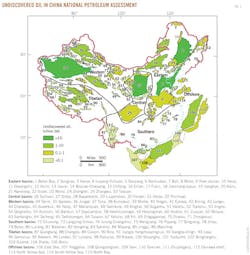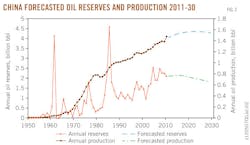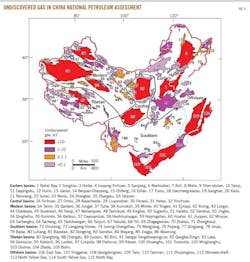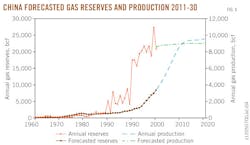Chenglin Liu
Chinese Academy of Geological Science
Beijing
Changbo Che
Jie Zhu
Fulin Yang
Ministry of Land and Resources
Beijing
Among the greatest uncertainties in future energy supply and a subject of considerable environmental concern is the amount of oil and natural gas yet to be found in China.
By using the same assessment software system, China's National Petroleum Assessment 2007 has assessed 115 basins, and China's National Petroleum Assessment 2010 has again evaluated six basins among these basins.
The assessment results show that China's undiscovered oil and gas recoverable resources are respectively 108.7 billion bbl of oil and 990.7 trillion cu ft of gas. Oil resources are mainly distributed in the four large-scale basins, including the Bohai Bay, Tarim, Ordos, and Songliao basins. Gas resources are mainly distributed in the three large-scale basins, including the Ordos, Tarim, and Sichuan basins.
It is forecast that the annual oil production will keep the stable increasing speed and the annual gas production will increase in a high speed in China before 2030. On an energy-equivalent basis, oil and gas production will be 3.52 billion bbl of oil, and gas will exceed oil at the end of 2030.
Introduction
Development of the Chinese economy has to face two challenges of energy supply and environmental protection.
Coal makes up about 70% of the primary energy consumption of China, while oil and gas contribute 60-70% of the primary energy consumption of the US and other developed counties. Under the situation of global low carbon development, China has been improving oil and gas production to satisfy energy demand and decrease coal consumption.
The amount of oil and gas yet to be found in China is related to both Chinese and global energy supply and environmental protection. In order to provide a perspective on the oil and gas resource potential of China, China's National Petroleum Assessment 2007 (CNPA 2007) has completed oil and gas assessment of 115 Chinese basins from 2003 to 2007.1-8
Based on results of the CNPA 2007, China's National Petroleum Assessment 2010 (CNPA 2010) has fulfilled oil and gas assessment of six basins, i.e., the Bohai Bay, Ordos, Sichuan, Zhujiangkou, Qiongdongnan, and North Bay basins, where there were apparent changes in oil and gas reserves and production between 2008 and 2010. By adding the assessment results of these six basins to the CNPA 2007's results of the other 109 basins, the CNPA 2010 affords a new look at the country's oil and gas resources.
China's onshore and offshore areas have 417 sedimentary basins. Most of these basins have already been explored. Overall, 34 basins have oil and gas reserves and production, and the six largest basins are Songliao, Bohai Bay, Ordos, Sichuan, Jungar, and Tarim.
By 2010, 873 oil and gas fields containing a total of 22.7 billion bbl of oil, 60.1 million bbl of gas liquids, and 127.1 tcf of gas have been developed, and oil and gas annual production from these fields is 1.5 billion bbl of oil and 3.3 tcf of gas.
Assessment methods and parameters
The CNPA 2007 evaluated in-place oil and gas resources, which are those quantities of petroleum at reservoirs which can be discoverable under current technical and economic conditions, and applied the recovery factor to estimate recoverable petroleum resources, which are those quantities of petroleum at reservoirs which can be recoverable under current technical and economic conditions.
The CNPA 2007 partitioned the country into a hierarchical series of geologic units: regions, basins, first class structure units, secondary class structure units, and fine assessment units. China was divided into six regions, i.e., the Eastern, Central, Western, Southern, Tibetan, and offshore regions.
The CNPA 2007 has evaluated conventional oil and gas resources in 115 basins, including 95 onshore basins and 10 offshore basins. The CNPA 2007 has also evaluated the petroleum resources' space distribution, including depth, formation, and natural geographic distribution.
The CNPA 2007 has developed the assessment software system in light of principles of statistical, analog, geochemical balance, volumetric methods, Delphi comprehensive assessment method, and Monte Carlo simulation. The parameter of the minimum field size (MFS) is used to exclude those resources from fields with sizes that are smaller than MFS for the assessment unit.9 Oil MFSs of onshore and offshore basins are 730,000 bbl and 2.2 million bbl, respectively, and gas MFS of all basins is 3.53 billion cu ft.
The CNPA 2010 has adopted the same assessment software system and petroleum MFS as used in CNPA 2007.
The CNPA relied mainly on petroleum exploration and exploitation data of China National Petroleum Corp. (CNPC), China National Petroleum and Chemical Corp. (SINOPEC), and China National Offshore Oil Corp. (CNOOC).
The cutoff date of the data used by the CNPA 2007 was the end of 2003. In the CNPA 2010, the cutoff date of the data for the Bohai Bay, Sichuan, Zhujiangkou, and Qiongdongnan basins was the end of 2007, while the cutoff date of the data for the Ordos and Beibuwan basins was the end of 2009.
Oil resources
The 2010 total undiscovered oil recoverable resource is in the range of 75.5-167.8 billion bbl with a mean of 108.7 billion bbl, which is 13.4 billion bbl larger than that of the CNPA 2007.
The main reasons for the growth include expansion of oil and gas exploration scale and renewing petroleum geology theory.
Among the six basins assessed by the CNPA 2010, the undiscovered oil recoverable resources of the Ordos and Bohai Bay basins increased to 14 billion bbl and 24.6 billion bbl, respectively, in CNPA 2010 from 10.5 billion bbl and 21.9 billion bbl in CNPA 2007, while the resources of the Zhujiangkou basin decreased to 3.8 billion bbl in CNPA 2010 from 4.4 billion bbl in CNPA 2010 (Fig. 1).
Oil resources are mainly distributed in the four large-scale basins, including the Bohai Bay, Tarim, Ordos, and Songliao basins, and total undiscovered oil recoverable resources of these basins account for 61% of the country-wide resources.
At yearend 2010, the cumulative proved recoverable oil reserves were 62.09 billion bbl, the cumulative oil production was 39.36 billion bbl, the remaining oil reserves were 22.65 billion bbl, and the oil reserves-production ratio was 16.
The multipeak Hubbert and Gauss models were used to forecast the oil reserves and production of China from 2011 through 2030.
Before 2030, the annual proved oil reserves of China will sustain the stable proving speed. The mean annual proved oil reserves of the country will be 7.73 billion bbl before 2020. From 2021 through 2030, the mean annual proved oil reserves of the country will be 7 billion bbl. At the end of 2030, the cumulative proved oil reserves will attain 187.70 billion bbl, and the proved degree of oil resources will be 58% in China.
Before 2030, the annual oil production of the country will keep the stable increasing speed. From 2011 to 2030, the annual oil production of the country is predicted to be, in 5-year intervals, 1.50 billion bbl, 1.57 billion bbl, 1.60 billion bbl, and 1.58 billion bbl. The annual oil peak production will not exceed 1.61 billion bbl. At the end of 2030, the cumulative oil production will be 38.17 billion bbl, and the proved share of oil resources will attain 41.65% in China (Fig. 2).
Gas resources
The total undiscovered recoverable gas resources of China are in the range of 756.3-1,307.5 tcf, with a mean of 990.7 tcf, which is 29.9 tcf larger than that of the CNPA 2007.
Among the six basins assessed in CNPA 2010, the undiscovered gas recoverable resources of the Ordos and Sichuan basins increased to 267 bcf and 162.8 bcf in CNPA 2010 from 77.6 bcf and 102.9 bcf of the CNPA 2007 (Fig. 3).
Gas resources are more concentrated than oil in China. Gas is mainly distributed in the three large-scale basins, Ordos, Tarim, and Sichuan. Undiscovered recoverable resources of these three basins account for 61.5% of the countrywide total.
Until the end of 2010, the cumulative proved gas reserves were 1,544.2 tcf, the cumulative gas production was 282.7 tcf, the remaining gas reserves were 1,261.5 tcf, and the reserves-production ratio was 41.
The future gas reserves and production of China were also forecast by the multipeak Hubbert and Gauss models. Before 2030, the annual proved gas reserves of China will sustain the high proving speed.
From 2011 to 2030, the mean annual gas reserves of the country will be, in 5-year intervals, 21.88 tcf, 22.24 tcf, 22.49 tcf, and 22.50 tcf. At the end of 2030, the cumulative proved gas reserves will attain 77.09 tcf and the proven degree of gas resources will be 42% in China. Before 2030, the annual gas production of the country will keep the high increasing speed.
From 2011 to 2030, the annual gas production of the country is predicted, at 5-year intervals, to be 4.79 tcf, 7.69 tcf, 9.26 tcf, and 9.46 tcf. At the end of 2030, the annual and cumulative gas production will be 9.54 tcf and 195.37 tcf, respectively, and the gas recovery degree will attain 17% in China (Fig. 4).
Uncertainty analyses
It is important to note that the assessments of the other 81 China land frontier basins (except for the 34 semimaturely and maturely explored basins) were, in many cases, based on limited geological data, and our understanding of petroleum resources in these basins will certainly change as more data become available.
In addition, the petroleum reserves and production forecasts were based on stable political and economic conditions, continuous exploration efforts, conventional oil estimates, and current exploration plays. If these factors change to great degree, the actual petroleum reserves and production will certainly be much different from the forecasted results in the next 20 years.
Acknowledgments
The authors acknowledge contributions from S. Sun with the Chinese Academy of Sciences, G.M. Zhai, C.X. Sheng, K.Q. Tian, and G.G. Wu with CNPC, S.W. Dai with SINOPEC, H.H. Zhang with CNOOC, and W.P. Liu, S.Q. Wang, and W. Zhao with China University of Petroleum.
References
1. China National Petroleum Assessment Team, "China national petroleum assessment 2007," China Land Press, Beijing, 2009, 383 pp.
2. China National Petroleum Assessment Team, "China national conventional petroleum resource assessment 2007," China Land Press, Beijing, 2009, 1,500 pp.
3. China National Petroleum Assessment Team, "Assessment software system and database of China national petroleum assessment 2007," China Land Press, Beijing, 2009, 129 pp.
4. China National Petroleum Assessment Team, "Future petroleum reserve and production forecast in China," China Land Press, Beijing, 2009, 268 pp.
5. Liu, C.L., Che, C.B., Zhu, J., and Yang, H.L., "China's endowment—2: China assesses unconventional land oil shale, oil sands, coal gas resources," OGJ, Vol. 108, No. 15, 2010, pp. 36-39.
6. Liu, C.L., Che, C.B., Zhu, J., Yang, H.L., and Fan, B.J., "Recovery factors of oil resources in China," Natural Resources Research, Vol. 19, No. 1, 2010, pp. 23-31.
7. Liu, C.L., Zhu, J., and Zhao, W., "Oil reserves, production forecast for 81 China land frontier basins," OGJ, Vol. 109, No. 6, 2011, pp. 62-66.
8. Zhu, J., Che, C.B., Yang, H.L., and Liu, C.L., "China's endowment—1: China assesses conventional resources in 115 basins," OGJ, Vol. 108, No. 14, 2010, pp. 32-35.
9. Schmoker, J.W., and Klett, T.R., "U.S. Geological Survey assessment model for undiscovered conventional oil, gas, and NGL resources—The Seventh Approximation," in USGS World Petroleum Assessment Team, eds., U.S. Geological Survey World Petroleum Assessment 2000, USGS Digital Data Series DDS-60, 4 CD-ROMs, 12 pp.
The authors
Chenglin Liu ([email protected]) was with the Research Institute of Petroleum Exploration and Development, PetroChina, from 1994 to 1999 and with China University of Petroleum from 2004 to 2011. Since 2004 he has been with the Institute of Geomechanics, Chinese Academy of Geological Science, working on petroleum resources assessment. He received a BA in petroleum geosciences and a PhD in mineralogy, petrology, and mineral deposit geology from China University of Petroleum.
Changbo Che ([email protected]) was with Geological Survey Division, Ministry of Land and Resources, from 1996 to 2002 and has been with Strategic Research Center for Oil & Gas Resources of the Ministry of Land and Resources working on energy policies and petroleum resources assessment since 2002. He received a BA in economics from NanKai University.
Jie Zhu ([email protected]) has been with Strategic Research Center for Oil & Gas Resources of the Ministry of Land and Resources, working on petroleum resources assessment and energy strategy since 2007. He received a BA in petroleum geosciences and a PhD in geological resources and geological engineering from China University of Petroleum.
Hulin Yang ([email protected]) was with Geological Survey Division, Ministry of Land and Resources, from 1986 to 2001 and has been with Strategic Research Center for Oil & Gas Resources of the Ministry of Land and Resources working on petroleum resources economic assessment and energy strategy since 2001. He received a BA in economics from NanKai University.
More Oil & Gas Journal Current Issue Articles
More Oil & Gas Journal Archives Issue Articles
View Oil and Gas Articles on PennEnergy.com




